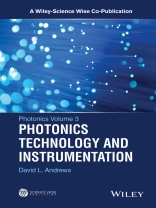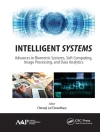Discusses the basic physical principles underlying the technology instrumentation of photonics
This volume discusses photonics technology and instrumentation. The topics discussed in this volume are: Communication Networks; Data Buffers; Defense and Security Applications; Detectors; Fiber Optics and Amplifiers; Green Photonics; Instrumentation and Metrology; Interferometers; Light-Harvesting Materials; Logic Devices; Optical Communications; Remote Sensing; Solar Energy; Solid-State Lighting; Wavelength Conversion- Comprehensive and accessible coverage of the whole of modern photonics
- Emphasizes processes and applications that specifically exploit photon attributes of light
- Deals with the rapidly advancing area of modern optics
- Chapters are written by top scientists in their field
Written for the graduate level student in physical sciences; Industrial and academic researchers in photonics, graduate students in the area; College lecturers, educators, policymakers, consultants, Scientific and technical libraries, government laboratories, NIH.
قائمة المحتويات
List of Contributors ix
Preface xi
1 Solid-State Lighting: Toward Smart and Ultraefficient Materials, Devices, Lamps, and Systems 1
M. H. Crawford, J. J. Wierer, A. J. Fischer, G. T. Wang, D. D. Koleske, G. S. Subramania, M. E. Coltrin, R. F. Karlicek, Jr., and J. Y. Tsao
1.1 A Brief History of SSL, 1
1.2 Beyond the State-of-the-Art: Smart and Ultraefficient SSL, 10
1.3 Ultraefficient SSL Lighting: Toward Multicolor Semiconductor Electroluminescence, 21
1.4 Smart Solid-State Lighting: Toward Control of Flux and Spectra in Time and Space, 42
1.5 Summary and Conclusions, 46
Acknowledgments, 46
References, 47
2 Integrated Optics Using High Contrast Gratings 57
Connie Chang-Hasnain and Weijian Yang
2.1 Introduction, 57
2.2 Physics of Near-Wavelength Grating, 58
2.3 Applications of HCGs, 77
2.4 Summary, 98
Acknowledgments, 98
References, 98
3 Plasmonic Crystals: Controlling Light with Periodically Structured Metal Films 107
Wayne Dickson, Gregory A. Wurtz and Anatoly V. Zayats
3.1 Introduction, 107
3.2 Surface Plasmon Polaritons, 110
3.3 Basics of Surface Plasmon Polaritonic Crystals, 113
3.4 Polarization and Wavelength Management with Plasmonic Crystals, 120
3.5 Chirped Plasmonic Crystals: Broadband and Broadangle SPP Antennas Based on Plasmonic Crystals, 138
3.6 Active Control of Light with Plasmonic Crystals, 146
3.7 Conclusion, 160
Acknowledgments, 160
References, 160
4 Optical Holography 169
Raymond K. Kostuk
4.1 Introduction, 169
4.2 Basic Concepts in Holography, 169
4.3 Hologram Analysis, 172
4.4 Hologram Geometries, 182
4.5 Holographic Recording Materials, 183
4.6 Digital Holography, 188
4.7 Computer Generated Holography, 193
4.8 Holographic Applications, 198
References, 208
5 Cloaking and Transformation Optics 215
Martin W. Mc Call
5.1 Introduction, 215
5.2 Theoretical Underpinning, 217
5.3 The Carpet Cloak, 226
5.4 Conformal Cloaking, 232
5.5 Spacetime Cloaking, 234
5.6 Conclusion and Outlook: Beyond Optics, 243
Appendix 5.A: Technicalities, 244
Appendix 5.B: Vectors and Tensors in Flat Spacetime, 245
Appendix 5.C: Maxwell’s Equations and Constitutive Relations in Covariant Form, 247
References, 251
6 Photonic Data Buffers 253
S. J. B. Yoo
6.1 Introduction, 253
6.2 Applications of Photonic Buffers, 254
6.3 Limitations of Electronics, 258
6.4 Photonic Buffer Technologies, 260
6.5 Integration Efforts, 278
6.6 Summary, 278
References, 278
7 Optical Forces, Trapping and Manipulation 287
Halina Rubinsztein-Dunlop, Alexander B. Stilgoe, Darryl Preece, Ann Bui, and Timo A. Nieminen
7.1 Introduction, 287
7.2 Theory of Optical Forces, 293
7.3 Theory of Optical Torques, 301
7.4 Measurement of Forces and Torques, 308
7.5 Calculation of Forces and Torques, 318
7.6 Conclusion, 329
References, 329
8 Optofluidics 341
Lin Pang, H. Matthew Chen, Lindsay M. Freeman, and Yeshaiahu Fainman
8.1 Introduction, 341
8.2 Photonics with Fluid Manipulation, 342
8.3 Fluidic Sensing, 350
8.4 Fluidic Enabled Imaging, 353
8.5 Fluid Assisted Nanopatterning, 358
8.6 Conclusions and Outlook, 361
Acknowledgments, 362
References, 362
9 Nanoplasmonic Sensing for Nanomaterials Science 369
Elin M. Larsson-Langhammer, Svetlana Syrenova, and Christoph Langhammer
9.1 Introduction, 369
9.2 Nanoplasmonic Sensing and Readout, 370
9.3 Inherent Limitations of Nanoplasmonic Sensors, 373
9.4 Direct Nanoplasmonic Sensing, 373
9.5 Indirect Nanoplasmonic Sensing, 374
9.6 Overview on Different Examples, 376
9.7 Discussion and Outlook, 396
References, 397
10 Laser Fabrication and Nanostructuring 403
Cemal Esen and Andreas Ostendorf
10.1 Introduction, 403
10.2 Laser Systems for Nanostructuring, 404
10.3 Surface Structuring by Laser Ablation, 409
10.4 Generation of thin Films by Laser Ablation in Vacuum, 416
10.5 Generation of Nanoparticles by Laser Ablation in Liquids, 419
10.6 Laser Induced Volume Structures, 423
10.7 Direct Writing of Polymer Components via Two-Photon Polymerization, 426
10.8 Conclusion, 431
References, 432
11 Free Electron Lasers for Photonics Technology by Wiley 445
George R. Neil and Gwyn P. Williams
11.1 Introduction, 445
11.2 Physical Principles, 446
11.3 Worldwide FEL Status, 462
11.4 Applications, 466
11.5 Summary and Conclusion, 471
References, 471
Index 477
عن المؤلف
David L. Andrews leads research on fundamental molecular photonics and energy transport, optomechanical forces and nonlinear optical phenomena. He has over 160 research papers and also eight books to his name – including the widely adopted textbook Lasers in Chemistry. The current focus of his research group is on novel mechanisms for optical nanomanipulation and switching, and light-harvesting in nanostructured molecular systems. The group enjoys strong international links, particularly with groups in Canada, Lithuania, New Zealand and the United States. Andrews is a Fellow of the Royal Society of Chemistry, and a Fellow of the Institute of Physics, and he is the inaugural Chair of the SPIE Nanotechnology Technical Group.












